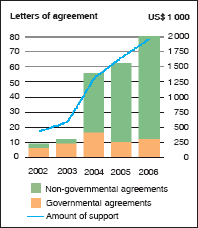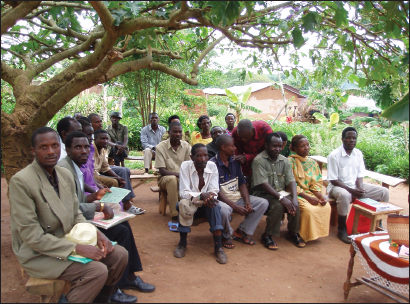Five years of the National Forest Programme Facility

The closure of the first five-year phase of the National Forest Programme Facility provides an occasion for reflection on how much this innovative partnership has accomplished in its short lifetime.
Founded in 2002 to help countries develop and implement national forest programmes (NFPs), the Facility seeks to help countries ensure that their NFPs effectively address local needs and national priorities through informed participation of civil society, while also reflecting internationally agreed principles. Its support is directed towards:
- building consensus on how to address forest related issues at the national level;
- integrating sustainable forest management into broader intersectoral processes, with a focus on poverty reduction;
- translating commitments at the international level into national forest policy and planning.
The Facility operates under the authority of a Steering Committee and is financed through a multidonor trust fund supported by the European Commission, Finland, France, Germany, Ireland, the Netherlands, Norway, Sweden, the United Kingdom and the United States. France, Germany and Japan provide in-kind support.
Most of the Facility funds go to country support to enable government and civil society actors to successfully manage and develop their NFP processes. The Facility’s trademark is to provide grants directly to stakeholders in partner countries based on a purely country-driven programme of activities and a competitive and transparent process for soliciting and selecting proposals for support. Catalytic funding supports capacity-building activities such as workshops and in-service training, policy analysis, and information sharing and knowledge management initiatives.
The Facility has now 46 partners including 21 African countries, nine countries in Asia and the Pacific, nine countries in Latin America and the Caribbean, three Central Asian countries and four subregional organizations (see Map). Unfortunately the demand for Facility support exceeds current funding; as a result many other applicants are still waiting to join.
By the end of 2006, the Facility had funded a total of about 220 grants to stakeholders at the country level, of which only 25 percent are governmental organizations. These grants have amounted to a total of about US$6 million, under ever-growing yearly allocations. The average amount made available to a partner country over three years has been US$300 000 (see Figure).
With the expanded number of partners, the range of NFP-related topics supported by the Facility has increased dramatically since 2002. New areas include:
- informed participation of stakeholders: developing knowledge and skills; raising awareness of NFP processes; sensitization of decision-makers on forest-related issues; establishment of consultation processes; establishment and development of forest information systems and knowledge-sharing and -management initiatives
- policy and strategy formulation at different levels: regional and subnational forest strategies and programmes; subsectoral strategies (e.g. afforestation/reforestation, agroforestry, protected areas, non-wood forest products, forest utilization, forestry education and research)
- broadening NFPs: integrating the Proposals for Action of the Intergovernmental Panel on Forests (IPF) and the Intergovernmental Forum on Forests (IFF) in national policy development; integrating NFPs into broader national strategies (poverty reduction, combating desertification, land-use planning); intersectoral coordination in NFP implementation; participatory forestry
- legal, fiscal and institutional instruments: new forest legislation; dissemination of forest-related laws and regulations; development of new funding mechanisms for forestry; enabling private investment in the forest sector; decentralization
Country support provided
by the National Forest Programme Facility, 2002–2006 |
 |
| National Forest Programme Facility partners |
 |
A second important function of the Facility is to facilitate the exchange of experience, information and knowledge relevant to NFP processes worldwide, both through its Web site (www.nfp-facility.org) and through regional workshops, networks and communities of practice. Information resources available on the site include the “NFP update” initiative, providing information about NFPs in more than 100 countries, and NFP Digests, which collect papers and Web links on a series of themes relevant to NFPs. To address the digital divide, the Facility is also producing a series of printed Readers containing abridged versions of the papers from the electronic digests.
The following are only some of the lessons that have come out of the Facility’s first five-year phase.
- Civil society participation is most efficient when non-governmental and community-based organizations are well organized. Even small projects funded by Facility grants can enhance effective participation.
- Significant results can be achieved with modest but well-targeted inputs.
- The employment of a multidonor trust fund has enhanced donor harmonization and reduced transaction costs for individual contributors.
- The selection of partner countries on the basis of clear criteria and procedures, under the authority of the multistakeholder Steering Committee, has raised countries’ confidence and trust in the Facility’s mandate and approach. The open and transparent process established by the Facility to allocate grants to stakeholders at the country level has also raised stakeholders’ trust in the NFP process and, in some partner countries, spread to other processes at the national level.
- The key challenge of the Facility in some partner countries is to ensure that forestry departments facilitate and coordinate the process but are not the sole implementers. This challenge is the very raison d’être of the Facility. Its staff is increasingly involved in coaching forestry departments and other country stakeholders.
For information: National Forest Programme Facility, FAO, Viale delle Terme di Caracalla, 00153 Rome, Italy; [email protected]
| With Facility assistance, a local association of tree growers in Mubende District, Uganda, gathers to discuss how to apply for government funding |
 |
J. Lejeune |
Some examples of Facility support to countries – Africa
Reviving the National Forest Policy in Nigeria
Starting in 2002, the Facility supported Nigeria in reviving its dormant NFP process by revamping the National Forestry Development Committee, whose role in leading the NFP process was obstructed by lack of funds. With Facility support, the committee embarked on revising the existing but outdated forest policy and formulating a related legal framework. The committee organized several stakeholder meetings to draft the new National Forest Policy and Forestry Act, which were officially adopted by Parliament in 2006. The broad stakeholder participation in the process was a new phenomenon for the country.
A database for forestry stakeholders in Tanzania
In the United Republic of Tanzania, special efforts are being made to construct strong foundations for good governance, empowerment of all stakeholders and facilitation of key stakeholders to partake in development processes. To this end, it is crucial to know who the forestry stakeholders are. With Facility support, Tanzania’s Chamber of Commerce, Industry and Agriculture conducted a survey of civil-society and private-sector organizations involved in the NFP process and developed an online database accessible to all containing detailed information about them. Field officers were trained to collect and validate the data and to maintain the Web site. |
|


